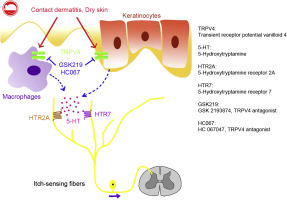Journal of Allergy and Clinical Immunology ( IF 14.2 ) Pub Date : 2017-08-11 , DOI: 10.1016/j.jaci.2017.05.051 Jialie Luo , Jing Feng , Guang Yu , Pu Yang , Madison R. Mack , Junhui Du , Weihua Yu , Aihua Qian , Yujin Zhang , Shenbin Liu , Shijin Yin , Amy Xu , Jizhong Cheng , Qingyun Liu , Roger G. O'Neil , Yang Xia , Liang Ma , Susan M. Carlton , Brian S. Kim , Kenneth Renner , Qin Liu , Hongzhen Hu

|
Background
Chronic itch is a highly debilitating symptom that underlies many medical disorders with no universally effective treatments. Although unique neuronal signaling cascades in the sensory ganglia and spinal cord have been shown to critically promote the pathogenesis of chronic itch, the role of skin-associated cells remains poorly understood.
Objective
We sought to examine the cutaneous mechanisms underlying transient receptor potential vanilloid 4 (TRPV4)–mediated allergic and nonallergic chronic itch.
Methods
Expression of TRPV4 in chronic itch and healthy control skin preparations was examined by using real-time RT-PCR. Trpv4eGFP mice were used to study the expression and function of TRPV4 in the skin by means of immunofluorescence staining, flow cytometry, calcium imaging, and patch-clamp recordings. Genetic and pharmacologic approaches were used to examine the role and underlying mechanisms of TRPV4 in mouse models of dry skin–associated chronic itch and spontaneous scratching associated with squaric acid dibutylester–induced allergic contact dermatitis.
Results
TRPV4 is selectively expressed by dermal macrophages and epidermal keratinocytes in mice. Lineage-specific deletion of TRPV4 in macrophages and keratinocytes reduces allergic and nonallergic chronic itch in mice, respectively. Importantly, TRPV4 expression is significantly increased in skin biopsy specimens from patients with chronic idiopathic pruritus in comparison with skin from healthy control subjects. Moreover, TRPV4-dependent chronic itch requires 5-hydroxytryptamine (5-HT) signaling secondary to activation of distinct 5-HT receptors in mice with allergic and those with nonallergic chronic itch conditions.
Conclusion
Our study reveals previously unrecognized mechanisms by which TRPV4-expressing epithelial and immune cells in the skin critically and dynamically mediate chronic itch and unravels novel targets for therapeutics in the setting of chronic itch.
中文翻译:

短暂受体潜在类香草酸4的巨噬细胞和角质形成细胞对过敏性和非过敏性慢性瘙痒的贡献不同
背景
慢性瘙痒是一种高度虚弱的症状,是许多医学疾病的基础,而没有普遍有效的治疗方法。尽管已经显示出感觉神经节和脊髓中独特的神经元信号级联可以关键地促进慢性瘙痒的发病机理,但是皮肤相关细胞的作用仍然知之甚少。
客观的
我们试图研究潜在的瞬态受体电位香草酸4(TRPV4)介导的过敏性和非过敏性慢性瘙痒的皮肤机制。
方法
通过使用实时RT-PCR检查TRPV4在慢性瘙痒和健康对照皮肤制剂中的表达。Trpv4 eGFP小鼠用于通过免疫荧光染色,流式细胞仪,钙成像和膜片钳记录来研究TRPV4在皮肤中的表达和功能。遗传和药理学方法用于检查TRPV4在与皮肤干燥相关的慢性瘙痒和与方酸二丁酯引起的过敏性接触性皮炎相关的自发性抓挠的小鼠模型中的作用和潜在机制。
结果
TRPV4由小鼠的真皮巨噬细胞和表皮角质形成细胞选择性表达。巨噬细胞和角质形成细胞中TRPV4的谱系特异性缺失分别减少了小鼠的过敏性和非过敏性慢性瘙痒。重要的是,与健康对照对象的皮肤相比,慢性特发性瘙痒患者的皮肤活检样本中TRPV4表达显着增加。此外,在患有过敏性和非过敏性慢性瘙痒病的小鼠中,依赖TRPV4的慢性瘙痒需要继发于独特的5-HT受体激活的5-羟色胺(5-HT)信号传导。
结论
我们的研究揭示了以前未知的机制,通过这些机制,皮肤中表达TRPV4的皮肤上皮细胞和免疫细胞可以动态地关键性地介导慢性瘙痒,并且可以为慢性瘙痒症的治疗提供新的靶点。



























 京公网安备 11010802027423号
京公网安备 11010802027423号